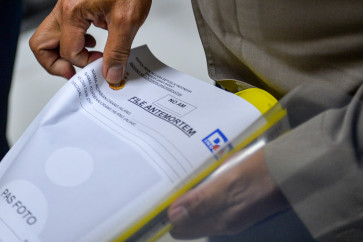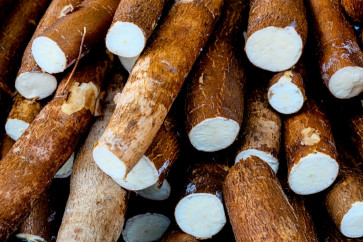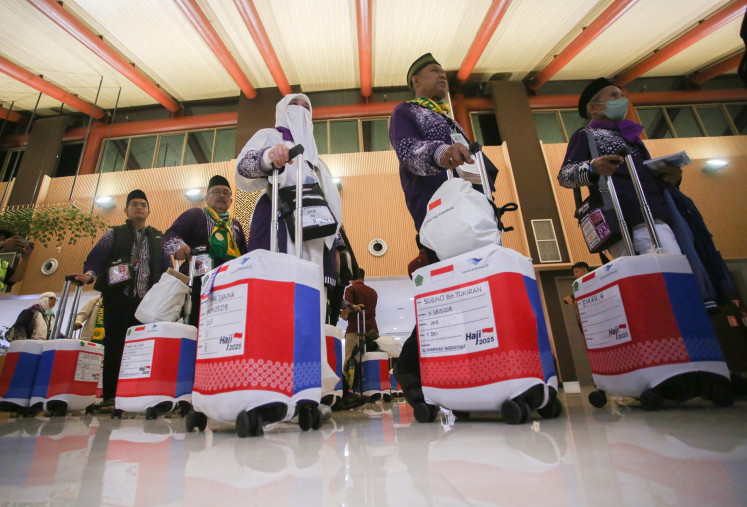In Solo, reviving Indonesia's tattoo culture
Under the gun: A tattoo artist from Taiwan is creates a design for a customer at the Skin Art Exhibition
Change text size
Gift Premium Articles
to Anyone

Under the gun: A tattoo artist from Taiwan is creates a design for a customer at the Skin Art Exhibition.
Dian Juli Afriga sat calmly, now and again calling to friends as they passed. Although holding a cigarette, she took drags only occasionally, showing no pain as a tattoo artist worked on the exposed flesh of her back.
As the 23-year-old's skin was pierced countless times by tattoo needles to insert ink into the layers underneath, Dian, who comes from Jakarta, claimed that she felt no pain. 'At first I was afraid as I noticed the pointy needles. But after I gave it a try, getting tattooed was like being bitten by ants,' she said at the Skin Art Exhibition 2013 in the Central Java Cultural Center in Surakarta (Solo), Central Java, recently.
Attracted to tattoos since junior high, Dian said that she first dared to get a tattoo only last year. 'Only ten years after I first watched people getting punctured did I have the guts to get my skin decorated.' So far, Dian has gotten five tattoos.
Her first was a picture of the dreamcatcher, an American Indian charm believed to make dreams come true. 'I used to feel down a lot when I faced my problems,' Dian said. 'This tattoo has given a boost to my spirit.'
Dian said that her parents disapproved at first, associating tattoos with hooliganism and other negative trends. 'But actually, such views are mistaken. Tattoos constitute an art form, like the painting. The difference is that the decorative designs use the body as a medium.'
Similarly, Dewi Ratih Septia Sumartiningtyas, said that she was addicted to tattoos, although conceding that the process hurt. 'But the pain is just addictive, let alone the wonderful images resulting from the process,' she said. To date, she has received four tattoos, including a black rose and a human skull on her back.
For Dewi Ratih, who is from Malang, East Java, tattoos are more than an art form or morale booster. 'Tattoos should have a meaning or philosophy in every design, because once the pictures are embedded in our skin, they will be very difficult or even impossible to remove.'
Despite the negative opinions held by many in Indonesia, tattooing has remained appealing, at least according to the enthusiasm shown by visitors to the exhibition on September 2 and 3. More than 160 tattoo artists from all over Indonesia and abroad enlivened the event.

Chief organizer Vincent Heru Boim claimed that the event, the second ever held in Solo, was the largest in Indonesia. 'The 164 tattooists participating in this exhibition are the largest number in the history of tattoo or skin art shows in Indonesia,' he noted. The foreign artists perking up the occasion came from Malaysia, Taiwan and the US.
Boim is aware that some circles in local society still attach a stigma to people adorned with tattoos. 'That's why this event has been organized 'in order to get rid of such a stigma and make the public realize that tattoos belong to the creative arts.'
According to Boim, promoting tattoos means preserving the indigenous arts of Indonesia. The oldest tattoos in the world originated in Mentawai Islands, West Sumatra, from which the art spread to the Dayak people in Kalimantan, where tattooing has become part of their culture. 'Up to the present day, the traditional motifs of the Mentawai and the Dayaks have been retained by Indonesian tattooists,' he said.
Narsen Afatara from 11 March University (UNS) in Solo agreed, saying that the residents of Mentawai had tattooed their bodies since their arrival on the western coast of Sumatra. The proto-Malays people came to the islands from Indochina during the Metal Age, between 2,500 and 4,000 years ago.
Apart from the Mentawai, a tradition of tattooing also existed in Egypt, Siberia, Britain, the Haida Indians in America, the Eskimos, the people of Hawaii and Marquesas Islands, the Rapa Nui people on Easter Islands, the Maoris in New Zealand and the Sumba in East Nusa Tenggara.

Contemporary tattoo artists, according to Narsen, can serve as mediators. 'The tattoo artists can fill the cultural vacuum of the younger generation. In the sphere of cultural research, the presence of cultural mediators is very important,' he added, taking note of the many tattooists designing ancient tattoo motifs in their works.
Tattooing has taken root in present-day society with relative ease because the practice was part of Indonesian culture, Narsen said. 'Tattoos have existed in Indonesia since antiquity, so this tattoo culture can't be considered absent from Indonesia'.
People today still believe in the spiritual side of the tattoo culture, he added. The motivation of tattoo design making is almost always based on the spiritual obsession of an individual. 'The one whose body is being tattooed wishes to realize his or her obsession, so that people can perceive the message to be conveyed ' or at least such designs serve as self-motivation.'
' Photos by Ade Rizal









